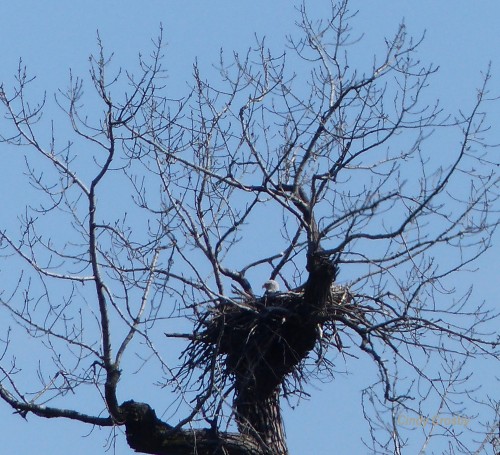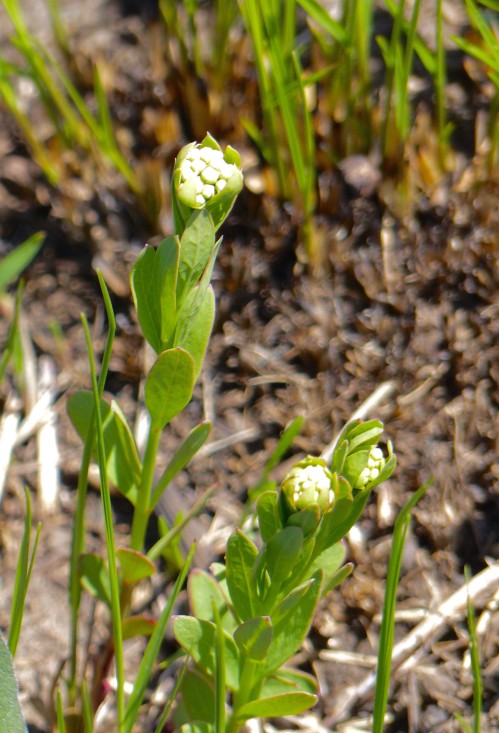“Oh, violets, you did signify, and what shall take your place?” — Mary Oliver
*****
It’s an exciting time in the Chicago region to be outdoors. From the hefty bald eagles, weighing up to 14 pounds, nesting and raising their young….

…to the tiniest blue-gray gnatcatchers, weighing in at a quarter of an ounce, hunting for nesting spots, the life of the skies is packed with surprises no matter where you look.
This past week, however, I’m mostly looking down at the prairie’s newly sprouting surface, trying to find violets. They were a favorite of my maternal grandmother, who left me her fine china, covered with the deep purple flowers. I walk the prairies daily through rain, snow, and heat—-a bizarre spring, even by Illinois standards—to see if I might find some. And I think of her as I walk.
On last Tuesday, I hiked with some of my prairie volunteers up to the savanna, where we looked closely at the savanna floor to find “harbinger of spring” in full bloom. Such a infinitesimal little wildflower! We eyeballed one up close for our educational and plant inventory needs, and left the rest of the 20 foot square large population remaining in peace.

I enjoyed the stroll on the savanna and prairie in the sunshine while it lasted. On Saturday, my marsh marigolds, ringing the tiny backyard prairie pond with gold, were shell-shocked by a sudden winter storm that dropped five inches of white stuff on us in 12 hours. The gold was beautiful in a whole new way for being under heavy snowfall. Just a different way of seeing them.
No word on how the chorus frogs felt about it.
By Sunday afternoon, the snowmelt had painted my backyard and the local prairies a bold, crisp green. It’s astonishing to see snow disappear so fast on the burned areas, and linger in the mowed or unburned sections. I went to shoot a photo of the contrast between burned and unburned prairie a few hours later. The snow was completely gone. So much changes from moment to moment, hour to hour, day to day, in April on the prairie. You have to be there, it seems, 24/7, to capture everything the tallgrass has to tell you.
The snow had fled by Monday, but bastard toadflax, which I adore, was coming into full bloom.

It was the first prairie wildflower name I ever learned. Twenty years ago or so, an older woman, Marge, was weeding sweet clover next to me as we volunteered on the prairie. “What’s this?” I asked her. “Oh that—bastard toadflax!” she told me. I was enchanted. Marge has since passed away, but I’ll never forget her taking time to help “the new kid” learn the name of a common prairie wildflower. I think of her whenever I see it.
Other bloomers I find on my hike are less common. As I walk the western suburban prairies in my area, a friend points out the prairie buttercup, a threatened species sparking its waxy gold in the sunshine. It’s a first for me!

This week, a more common flower—the wild strawberry—-is up, salting the emerald grasses with white. The strawberry blooms poke through the crevices of the paver path, rubbing shoulders with…the violets. Can you ID this violet? (Hint: It’s not the common violet!) If you aren’t sure, read on….

Of course there are the common violets. The blue violet, Viola sororia, is our state flower. Often, when I teach prairie wildflowers, a student will see violets and say—Hey, I’m trying to weed those out of my yard! Common violets can be a nuisance to some. But to me, they are beautiful, if only for the association with my grandmother. The common violets have lovely heart-shaped leaves and add a welcome splotch of purple to the prairie when not much else is in bloom. The leaves and flowers are edible. High in Vitamin C!
 I love seeing the variations in color—from white to yellow to blue to purple— but distinguishing between the violets is difficult for this naturalist. Lumpers and splitters, those taxonomists who decide what we call each species, further muddle the issue for me. Supposedly, there are eight kinds of blue violets in our state, depending on who you read. And it doesn’t help that the violets love a good party, and many hybridize without any compunctions about taxonomy.
I love seeing the variations in color—from white to yellow to blue to purple— but distinguishing between the violets is difficult for this naturalist. Lumpers and splitters, those taxonomists who decide what we call each species, further muddle the issue for me. Supposedly, there are eight kinds of blue violets in our state, depending on who you read. And it doesn’t help that the violets love a good party, and many hybridize without any compunctions about taxonomy.
The two I can ID with certainty are special. It’s the prairie violets (Viola pedatifida) that I see in profusion on the Schulenberg Prairie where I’m a steward, and on the Belmont Prairie remnant not far away. I tip each flower face up and look for the hairy white interior that says: prairie violet. This is also the one on the paver path shown above, with the wild strawberries. Bet you guessed it right.

Occasionally, I see the brilliant golden orange anthers of birdfoot violet (Viola pedata), which I encounter at Nachusa Grasslands in Franklin Grove, IL, about 90 miles west. I look at the leaves to help make the ID. Deeply lobed; birdfoot violet. Less lobed, prairie violet. The birdfoot violet leaves do look like little bird’s feet, don’t they? This bloom has a tiny pollinator.

We’ve lost the birdfoot violets over the past few years on the Schulenberg Prairie. I’ve spent part of my April trying to find a local seed source within 30 miles to jump start a new population. (Any help appreciated! Leave me a comment.) Every missing species is a piece of the prairie puzzle. Lose one species, and the picture seems incomplete.
And who would want to lose one of the violets? My grandmother has been gone now for more than a decade. I think of her when I show my six grandchildren a violet, or help them ID a bird, or we catch a dragonfly together. It’s her work I’m passing on—her love for the outdoors, which she handed on to my mother, who ensured it was instilled in me. When I drink from one of grandma’s violet patterned teacups, I think of the strong women in my family and their legacy of learning to pay attention to the natural world. It’s their gift to me.

Now, it’s my turn to share.
*****
The opening lines are from the lovely poem, Violets, by Mary Oliver (1935-2019) in her poetry collection, Evidence (Beacon Press, 2009). She passed away in January. If you haven’t read Mary Oliver, consider beginning with New and Selected Poems Volume 1.
*****
All photos and video clip copyright Cindy Crosby (top to bottom): Bald eagle (Haliaeetus leucocephalus) nesting, Chicago region; a prairie steward examines harbinger of spring (Erigenia bulbosa), Schulenberg Prairie Savanna, The Morton Arboretum, Lisle, IL; video clip of marsh marigolds (Caltha palustris) in the snow, author’s backyard pond, Glen Ellyn, IL; bastard toadflax (Comandra umbellata), Schulenberg Prairie, The Morton Arboretum, Lisle, IL; prairie buttercup (Ranunculus rhomboideus) , DuPage County, IL; wild strawberries (Fragaria virginiana) and prairie violets (Viola pedatifida) in the paver path, Belmont Prairie Preserve, Downer’s Grove, IL; common violet (Viola sororia), The Morton Arboretum, Lisle, IL; prairie violet (Viola pedatifida), Schulenberg Prairie, The Morton Arboretum, Lisle, IL, birdfoot violet (Viola pedata), Nachusa Grasslands, Franklin Grove, IL, nest (possibly a robin’s? ID help welcome!), Schulenberg Prairie Savanna, The Morton Arboretum, Lisle, IL. Thank you to Paul Marcum of Illinois Botany for help on the prairie buttercup ID.
Cindy’s Classes and Speaking (see more at http://www.cindycrosby.com)
Tallgrass Prairie Ecology Online continues (through the Morton Arboretum) this week. Registration for the June 26 class is here.
Saturday, May 4– Spring Woodland and Early Prairie Wildflower Walk, The Morton Arboretum, Lisle, IL. (Sold Out)
Thursday, May 9–Dragonflies and Damselflies: Frequent Flyers of the Garden, Hilltop Garden Club, 10-11 a.m., Oswego Public Library, 32 West Jefferson Street, Oswego, IL. Free and Open to the Public.

By any chance was it Marge Kammreer? (Sp?). She was the inspiration for my first wild flowers in my yard. What a wonderful woman. And……my grandma too, loved violets. We picked stems for a skinny vase when having tea parties on days she we spent climbing through a window in her home to access the “screened in side porch”. Thank you for reminding me of treasured days long ago.
LikeLiked by 1 person
Hello, Connie, and thank you for taking time to read the blog this week and comment. I love it that your grandma also cared about violets. Such memories! We are fortunate, aren’t we? Marge’s last name is lost to me now… she volunteered on Tuesday evenings at the Schulenberg, and was always ever-patient with a young woman who knew nothing about prairie plants. I’m grateful to her, and the many men and women like her, who take time to share and instruct. Wouldn’t it be amazing if it was the same Marge? I love that!
LikeLike
Cindy, maybe you should look into planting water lilies in the prairie?
LikeLiked by 1 person
Snowdrops, cactus, and water lilies have all crossed my mind this past week, Mike! Never a dull moment…. 🙂 Thanks for reading, and enjoy the weather!
LikeLike
True Viola pedatifida has the leaf divisions that are more linear to spatulate. What you have looks like what “Swink and Wilhelm” would call Viola subsinuata. In my experience, this violet is usually found in or on the edge of oak savanna. However, they might have lumped this species into the hybrid V. x benardii. If it is a hybrid, it seems to be very stable with a fidelity to a certain habitat type.
LikeLiked by 1 person
Hello, James, and thank you for taking time to read and comment. The violets are difficult, aren’t they? My favorite phrase with violets is, “I could be wrong!” I appreciate your ID’s, and I always like a chance to expand my knowledge of the violets. I see a lot of variation in pedatifida between prairies— I’m sure I have much to learn.
Hope you enjoy the violets on the prairies where you hike this spring, and thank you for taking time to add to my violet knowledge!
Cindy
LikeLike